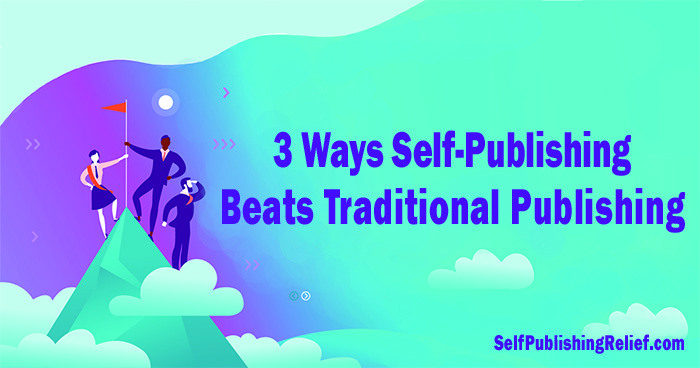
For many years, being published by one of the big-name publishing houses was the ultimate goal for book authors. And traditional publishing still offers writers many perks, including no out-of-pocket costs, brand name recognition, access to industry professionals, and having much of the post-writing editing work performed in-house. But the experts at Self-Publishing Relief know that self-publishing has become a legitimate, viable, and popular alternative to traditional publishing for many authors—and readers! Here are 3 ways self-publishing beats traditional publishing.
3 Ways Self-Publishing Beats Traditional Publishing
Better Timeline And Faster Turnaround. When your book is published traditionally, it typically takes 1-2 years before it actually appears in bookstores. Self-publishing, however, allows you to complete the process at your own pace. You’re in charge, which means you can tailor the timeline to suit your schedule. As a result, your book could be published in a matter of weeks or months rather than years! Just be sure to have a plan in place before you begin in order to prevent your project from going off the rails and taking far longer than you intended.
Control Over Every Decision. When your book is traditionally published, you don’t get a lot of say about the cover design or the final title: These are decided by the publishing house. If you choose to self-publish, however, you’ll never have to compromise on your vision for your book. From title to cover design to interior formatting to fonts, every choice is yours in the self-publishing process.
Of course, you should definitely outsource and hire professional help to make your vision a reality. You don’t want your self-published book to look amateurish.
Larger Cut Of The Profits. In addition to controlling how your book looks and how much you spend to get it ready for self-publishing, you also determine the price point—which means you have more control over your royalties. Of course, there’s no guarantee your self-published book will sell, but there’s no guarantee a traditionally published book will sell either. While traditionally published authors get around 10%-15% of the book’s list price as a royalty, self-published authors can earn around 40% – 70%. That’s a huge difference!
Nowadays, whether your book is traditionally published or self-published, you are responsible for a majority of the marketing efforts. So your book’s success—and the profits you make—will depend on your efforts to spread the word and connect with readers. The better you are at marketing your book, the more sales you’ll make. For self-published authors, this means a bigger chunk of the royalties will end up in your pocket.
If you’re still on the fence about whether or not to self-publish, keep in mind that a successful self-published book can go on to be traditionally published! In fact, having a self-published book that sells well has an advantage when it comes to attracting potential agents and traditional publishers: You’ve already demonstrated that there’s a buying market interested in your book. Self-publishing has the potential to be a great stepping stone to a traditional publishing contract!
While self-publishing your novel, memoir, self-help book, short story collection, or poetry collection can be a lot of work and time-consuming, the benefits can make it worth the effort. And if you don’t want to tackle self-publishing alone, the experts at Self-Publishing Relief are here for you! We’ll guide you through every step and help you create a self-published book that you’ll be proud to put your name on. Contact us today for a free, no-obligation consultation call to see if self-publishing is right for you.
Question: Which benefit of self-publishing seems best to you?





